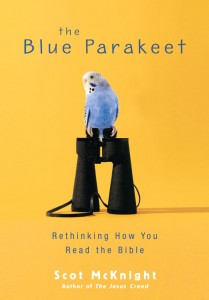The Blue Parakeet by Scot McKnight
The Blue Parakeet was one of those books that, as soon as I heard the title and what it was about it, I immediately wanted to read it. After all, what do blue parakeets have to do with reading the Bible? It piqued my curiosity.
Scot McKnight’s book does not disappointment, and will be a recommended resource, right alongside How to Read the Bible for All Its Worth and Grasping God’s Word, every time I teach exegesis and hermeneutics. He has caused me to reconsider how I read the Bible, and how I should teach others to read it. I’ll comment on just two elements of the book, and leave the rest for you to discover on your own.
 One of Dr. McKnight’s best insights is to see the whole Bible as a narrative—a Story. While I have believed this for a while myself, I don’t think I had connected the dots the same way that he had. I had always understood the Bible to be a collection of different genres of literature that, together, form the story of God’s process to redeem and restore creation. In the Blue Parakeet, Dr. McKnight shows that the Bible is, in fact, a single narrative (from a genre/literary type perspective) that contains other genres of literature as sub-genres. That is to say, the Bible is a story that uses poetry, proverbs, prophecies, laws, and apocalypses to move the plot forward. This is a subtle but important difference in the way we see the Bible as a unified whole.
One of Dr. McKnight’s best insights is to see the whole Bible as a narrative—a Story. While I have believed this for a while myself, I don’t think I had connected the dots the same way that he had. I had always understood the Bible to be a collection of different genres of literature that, together, form the story of God’s process to redeem and restore creation. In the Blue Parakeet, Dr. McKnight shows that the Bible is, in fact, a single narrative (from a genre/literary type perspective) that contains other genres of literature as sub-genres. That is to say, the Bible is a story that uses poetry, proverbs, prophecies, laws, and apocalypses to move the plot forward. This is a subtle but important difference in the way we see the Bible as a unified whole.
The second comment I’d like to make is the way Dr. McKnight pulls back the curtain on the way that we (evangelicals or whomever) select which passages of Scripture to obey and those to which we say, “That was then, this is now.” He calls this process “discernment”. Though many of us claim to obey Scripture (or attempt to) fully, in reality we all make discernments about how and what to obey. After all, how many of us make certain to wear clothing woven of only one material?
His point is not to call us all disobedient idolaters, but rather to demonstrate that, intentionally or unintentionally, we all translate the Bible “in our day in our way.” We all say about something in the Bible, “that was then but this is now,” so let’s be honest about it and think more critically about how and with what we do this. It’s not a bad thing, he says, because even the characters of the Bible did this (e.g., Paul and Torah).
All in all, The Blue Parakeet was an eye-opening book on how we approach the Scriptures. I commend it to you as an excellent resource for anyone who wants to read the Bible better.

